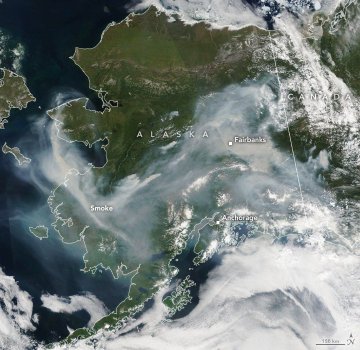By Adriana Navarro, AccuWeather staff writer
The smoke from over 400 forest fires in Siberia reached Alaska and portions of the west coast of Canada by July 31, according to NASA.
The Russian regions of Irkutsk, Buryatia, Sakha and Krasnoyarsk have declared states of emergency as the smoke chokes cities downwind, according to the Associated Press. All smoke can be hazardous, especially for the young or elderly.
However, NASA scientists don't believe the smoke will be traveling low enough in the U.S. to impact air quality.

Smoke from a multitude of wildfires in Siberia has swept across the Pacific and reached Alaska and northwestern Canada. (NOAA/NASA)
"The smoke travels at such high altitudes that it's unlikely to significantly impact air quality in the U.S., unless wind currents reach the surface," Atmospheric Scientist Colin Seftor said. Seftor works at NASA's Goddard Space Flight Center and has been tracking the smoke through its journey, according to the National Oceanic and Atmospheric Administration.
AccuWeather Senior Meteorologist Bob Smerbeck said that a storm tracking from Russia across the Bering Sea and into Alaska had steered the smoke into the area.
"Smoke can still be an issue this weekend," Smerbeck said.
RELATED:
'It's just a matter of time:' Despite fewer wildfires so far in 2019, California braces for another busy fire season
The most common ways people spark devastating wildfires in the US
How destructive wildfires create their own weather
What you can do to help prevent deadly, devastating wildfires from occurring
When a wildfire is 100-percent 'contained,' does that mean the blaze is completely extinguished?
'It's just a matter of time:' Despite fewer wildfires so far in 2019, California braces for another busy fire season
The most common ways people spark devastating wildfires in the US
How destructive wildfires create their own weather
What you can do to help prevent deadly, devastating wildfires from occurring
When a wildfire is 100-percent 'contained,' does that mean the blaze is completely extinguished?
NASA identified the smoke through an aerosol index from the Suomi-NPP satellite's Ozone Mapping and Profiler Suite (OMPS) instrument.
According to Russia's Federal Forestry Agency, more than 2.7 million hectares (6,671,845 acres) of Siberian forest is currently ablaze across six different Siberian and Far East regions. It all adds up to about the size of Massachusetts.
Russian officials have stated that although the fires have not encroached upon populated areas, about 800 cities are blanketed in heavy smoke, including larger cities such as Noosibirk, Krasnoyarsk and Chita, the AP reported. It is suspected that some of these fires were started by lightning strikes.
Over 300 of the forest fires are burning in remote areas of Siberia that are "difficult to reach," the Avialesoohrana forest protection agency said, according to DW News.
The agency is not fighting the fires in the remote areas that are burning up to 2.88 million hectares (7.12 million acres) because "there was no threat to population centers and economic objects, and the projected losses through firefighting surpass the potential damage of the fires," according to a statement from the agency cited by the Interfax news agency.
"There will be a storm system crossing Siberia that will cause showers and thunderstorms over the fire areas this weekend, which will help to put out the fires, but lightning could also start new ones," Smerbeck said.
"The pattern may shift later next week as storms with rain and cooler air shift eastward into the western regions of the fire zones. It may take a while to reach the central and eastern fire zone areas," he added.
You may have heard about firesburning in the #Arctic. In June & July of this year, there have been more than 100 intense & long-burning fires in the region. These fires have some far-reaching consequences
twitter.com/NASAEarth/stat…
In Alaska, more than 400 fireshave been reported in 2019. In early July, NASA’s Aqua satellite captured this image of smoke from wildfires billowing over most of the state. On July 24, much of central northern Asia was covered in smoke
from Siberian fires.
54 people are talking about this




No comments:
Post a Comment